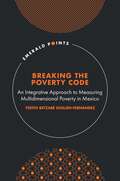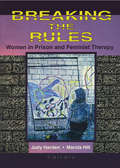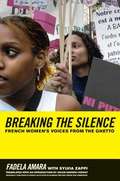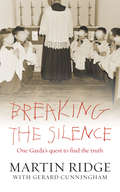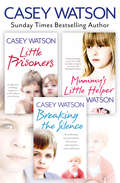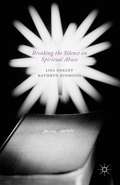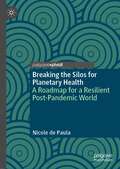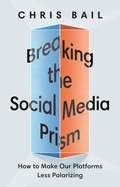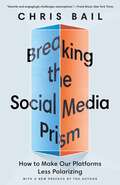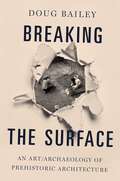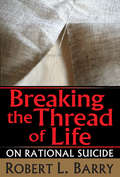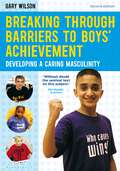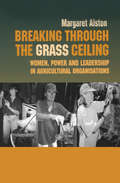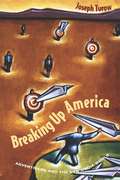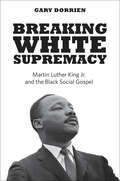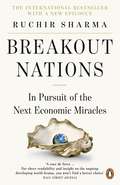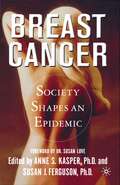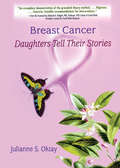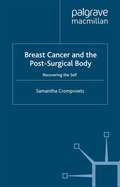- Table View
- List View
Breaking the Poverty Code: An Integrative Approach to Measuring Multidimensional Poverty in Mexico (Emerald Points)
by Yedith Betzabé Guillén-FernándezA lack of socially determined needs, such as nourishment, education, and healthcare, can become deprivation indicators that are used to measure poverty. Breaking the Poverty Code recognizes that any mismeasurement may provide inaccurate information to policymakers about the extent of poverty in the population, potentially inhibiting the success of policy initiatives moving forward. Advocating for a more objective measurement, Yedith Betzabé Guillén-Fernández reinvents how poverty is presented and defined by exploring methods currently employed by CONEVAL, the institution in charge of applying the official methodology for multidimensional poverty in Mexico. With this context in mind, Yedith argues for the implementation of the ‘Consensual approach’ to inform the ‘Social Rights-based approach’ as a way to update criteria for living standards. Calling for a more holistic conception of poverty that accounts for evolving socioeconomic and technological needs, chapters highlight both British and Latin American scholarship to emphasize the fluidity that must be taken into account when defining poverty. Transcending the Mexican context, this book presents critical sociological observations that fuse the importance of statistical data with the lived realities of impoverished people everywhere.
Breaking the Rules: Women in Prison and Feminist Therapy
by Marcia Hill Judith HardenBreaking the Rules: Women in Prison and Feminist Therapy challenges therapists, public policymakers, voters, and those in the criminal justice system to find treatment options, empowerment strategies, viable resources, community support, and policies that can help women with problems such as drug abuse, domestic violence, poverty, and prostitution rather than perpetually punishing them.Breaking the Rules shows you how our society makes ‘other’of those among us who are most vulnerable, injured, and without resources. It digs under your skin and forces you to look at: the histories of abuse among women who have murdered their partners the impact of race and ethnicity on patterns of mothering and caretaking of children of women prisoners the lack of treatment options for addicted women prisoners how prison reawakens the feelings of powerlessness in women who have suffered childhood physical and sexual abuse helping women inmates develop marketable educational and vocational skills, support systems, and positive perceptions of themselves collaborative strategies that challenge the status quo of programs and support available to female offenders and their families a relational model of treatment that is based on the integration of three theoretical perspectives the strengths and limitations of twelve step programs for womenMapping the problems and offering solutions, Breaking the Rules walks you through treatment strategies and self-confirming experiences--such as feminist therapy, prisoner-led support groups, affirmative prison programming, and art therapy--that help women draw on their strengths, come to terms with their pasts, and meet future challenges head on.
Breaking the Rules: Women in Prison and Feminist Therapy
by Marcia Hill Judith HardenBreaking the Rules: Women in Prison and Feminist Therapy challenges therapists, public policymakers, voters, and those in the criminal justice system to find treatment options, empowerment strategies, viable resources, community support, and policies that can help women with problems such as drug abuse, domestic violence, poverty, and prostitution rather than perpetually punishing them.Breaking the Rules shows you how our society makes ‘other’of those among us who are most vulnerable, injured, and without resources. It digs under your skin and forces you to look at: the histories of abuse among women who have murdered their partners the impact of race and ethnicity on patterns of mothering and caretaking of children of women prisoners the lack of treatment options for addicted women prisoners how prison reawakens the feelings of powerlessness in women who have suffered childhood physical and sexual abuse helping women inmates develop marketable educational and vocational skills, support systems, and positive perceptions of themselves collaborative strategies that challenge the status quo of programs and support available to female offenders and their families a relational model of treatment that is based on the integration of three theoretical perspectives the strengths and limitations of twelve step programs for womenMapping the problems and offering solutions, Breaking the Rules walks you through treatment strategies and self-confirming experiences--such as feminist therapy, prisoner-led support groups, affirmative prison programming, and art therapy--that help women draw on their strengths, come to terms with their pasts, and meet future challenges head on.
Breaking the Silence: French Women’s Voices from the Ghetto (PDF)
by Fadela Amara Sylvia Zappi Translated an Introduction by Helen Harden ChenutBorn in France of Algerian parents, Fadela Amara is a human rights activist who speaks with both a personal and a collective voice. This book is a passionate account of her struggle to found the movement called “Ni Putes Ni Soumises” (Neither Whore Nor Submissive), aimed at shattering the law of silence about violence against women within French suburban communities. The questions Amara raises are part of a broader agenda to open contemporary French society to greater ethnic and cultural diversity. These issues also pose problems of national identity and the defense of secularism for the state. As France increasingly confronts such tensions and the emergence of Islamic movements, French cities face problems of unemployment, racial and ethnic discrimination, and violence. Amara's eloquent call for social and gender equality underscores a host of interconnected issues, including France's colonial past and the degradation of the suburbs into ghettos that have progressively marginalized immigrant and working-class communities. Amara and her co-workers have challenged the French Republic's leaders using a strategy that champions republican secular values and stresses the language of universalism to advance individual rights. Women's rights are human rights, they argue, thus casting their demands for equality in terms of a broader struggle for democratic freedoms. Moving, candid, and timely, Breaking the Silence created a sensation when it was published in France. Fadela Amara is currently State Minister for Urban Affairs, charged with the rehabilitation of the very ghettos she describes.
Breaking the Silence: One Man's Quest to Find the Truth About One of the Most Horrific Series of Sex Abuse Cases in Ireland
by Martin Ridge Gerard CunninghamAssigned to a quiet corner of Ireland's most remote county, Martin Ridge was heading for retirement after a long career with An Garda Síochána, the Irish police force. All that changed when a call from a local priest set in motion what would become the most horrific sex abuse investigation the island had ever known.At Christmas 1997 a local priest Fr Eugene Greene reported to the Gardaí that a man had tried to blackmail him. This call, an act of hubris, set in motion a Garda investigation that revealed him to be a serial abuser of children. As word of the investigation spread, 26 men came forward. Most were from the tiny Irish-speaking parish of Gort an Choirce. All had been abused by Greene as children.Soon after, another man came forward to say that he had been sexually abused by a local schoolteacher, Denis McGinley. As Ridge dug deeper, he discovered that McGinley had been systematically abusing children in his classroom for decades. He had at least 50 victims.The Greene and McGinley cases both involved the Catholic Church. Greene was a priest, and McGinley a teacher in a Catholic school answerable to religious managers. As Ridge investigated, he discovered that the Church knew about the abuse, but ignored the problem.Brilliantly written and unsparing in its fidelity to the truth, Breaking the Silence is more than an account of a police investigation: it’s the story of an entire community’s struggle to come to terms with its betrayal by those in whom it placed the most trust.
Breaking the Silence, Little Prisoners and Mummy’s Little Helper 3-in-1 Collection
by Casey WatsonSunday Times bestselling author and foster carer Casey Watson’s inspiring memoirs Mummy’s Little Helper and Little Prisoners combined in a single volume with her deeply moving latest title Breaking the Silence, about two troubled little boys who both desperately need a loving home, and find comfort and friendship in the most unlikely of places.
Breaking the Silence on Spiritual Abuse
by L. Oakley K. KinmondProviding a balance of empirical research and practical concerns, this book explores the definitions and historical context of spiritual abuse, outlines a process model for the different stages of spiritual abuse and includes strategies for therapists working with survivors of spiritual abuse.
Breaking the Silos for Planetary Health: A Roadmap for a Resilient Post-Pandemic World
by Nicole de PaulaThis book translates the latest theoretical perspectives on the emerging field of Planetary Health Studies into the practical reality of global political decision makers. It builds on the scientific data on the impacts of environmental change on human health to propose practical methods for operationalizing planetary health. The book maps opportunities for decision makers to break institutional silos and engage with bottom-up approaches that can transform planetary health from a global idea into a local reality. The analysis frames human health in the Anthropocene, an era in which humans have become the most powerful force affecting global ecosystems, and reveals new existential risks for humankind.Departing from ongoing multilateral efforts to promote sustainability, the author’s analysis places the agenda of planetary health on the desk of political decision makers, still underrepresented at planetary health gatherings. Given the pressing need to implement sustainable development policies, the book presents planetary health as an overarching framework for global policy targets, notably the UN Sustainable Development Goals, the Paris Agreement on Climate Change, and the post-2020 biodiversity framework under the UN Convention on Biological Diversity. The book is timely in offering a concrete road map for practitioners and researchers interested in transforming the concept of planetary health into reality. With a collection of success stories, the analysis dwells on tools for community engagement, opportunities for health professionals training, gender empowerment, digital health, and innovative ways to enhance human well-being on a changing planet.
Breaking the Social Media Prism: How to Make Our Platforms Less Polarizing
by Chris BailA revealing look at how user behavior is powering deep social divisions online—and how we might yet defeat political tribalism on social mediaIn an era of increasing social isolation, platforms like Facebook and Twitter are among the most important tools we have to understand each other. We use social media as a mirror to decipher our place in society but, as Chris Bail explains, it functions more like a prism that distorts our identities, empowers status-seeking extremists, and renders moderates all but invisible. Breaking the Social Media Prism challenges common myths about echo chambers, foreign misinformation campaigns, and radicalizing algorithms, revealing that the solution to political tribalism lies deep inside ourselves.Drawing on innovative online experiments and in-depth interviews with social media users from across the political spectrum, this book explains why stepping outside of our echo chambers can make us more polarized, not less. Bail takes you inside the minds of online extremists through vivid narratives that trace their lives on the platforms and off—detailing how they dominate public discourse at the expense of the moderate majority. Wherever you stand on the spectrum of user behavior and political opinion, he offers fresh solutions to counter political tribalism from the bottom up and the top down. He introduces new apps and bots to help readers avoid misperceptions and engage in better conversations with the other side. Finally, he explores what the virtual public square might look like if we could hit "reset" and redesign social media from scratch through a first-of-its-kind experiment on a new social media platform built for scientific research.Providing data-driven recommendations for strengthening our social media connections, Breaking the Social Media Prism shows how to combat online polarization without deleting our accounts.
Breaking the Social Media Prism: How to Make Our Platforms Less Polarizing
by Chris BailA revealing look at how user behavior is powering deep social divisions online—and how we might yet defeat political tribalism on social mediaIn an era of increasing social isolation, platforms like Facebook and Twitter are among the most important tools we have to understand each other. We use social media as a mirror to decipher our place in society but, as Chris Bail explains, it functions more like a prism that distorts our identities, empowers status-seeking extremists, and renders moderates all but invisible. Breaking the Social Media Prism challenges common myths about echo chambers, foreign misinformation campaigns, and radicalizing algorithms, revealing that the solution to political tribalism lies deep inside ourselves.Drawing on innovative online experiments and in-depth interviews with social media users from across the political spectrum, this book explains why stepping outside of our echo chambers can make us more polarized, not less. Bail takes you inside the minds of online extremists through vivid narratives that trace their lives on the platforms and off—detailing how they dominate public discourse at the expense of the moderate majority. Wherever you stand on the spectrum of user behavior and political opinion, he offers fresh solutions to counter political tribalism from the bottom up and the top down. He introduces new apps and bots to help readers avoid misperceptions and engage in better conversations with the other side. Finally, he explores what the virtual public square might look like if we could hit "reset" and redesign social media from scratch through a first-of-its-kind experiment on a new social media platform built for scientific research.Providing data-driven recommendations for strengthening our social media connections, Breaking the Social Media Prism shows how to combat online polarization without deleting our accounts.
Breaking the Surface: An Art/Archaeology of Prehistoric Architecture
by Doug BaileyIn Breaking the Surface, Doug Bailey offers a radical alternative for understanding Neolithic houses, providing much-needed insight not just into prehistoric practice, but into another way of doing archaeology. Using his years of fieldwork experience excavating the early Neolithic pit-houses of southeastern Europe, Bailey exposes and elucidates a previously under-theorized aspect of prehistoric pit construction: the actions and consequences of digging defined as breaking the surface of the ground. Breaking the Surface works through the consequences of this redefinition in order to redirect scholarship on the excavation and interpretation of pit-houses in Neolithic Europe, offering detailed critiques of current interpretations of these earliest European architectural constructions. The work of the book is performed by juxtaposing richly detailed discussions of archaeological sites (Etton and The Wilsford Shaft in the UK, and Magura in Romania), with the work of three artists-who-cut (Ron Athey, Gordon Matta-Clark, Lucio Fontana), with deep and detailed examinations of the philosophy of holes, the perceptual psychology of shapes, and the linguistic anthropology of cutting and breaking words, as well as with cultural diversity in framing spatial reference and through an examination of pre-modern ungrounded ways of living. Breaking the Surface is as much a creative act on its own-in its mixture of work from disparate periods and regions, its use of radical text interruption, and its juxtaposition of text and imagery-as it is an interpretive statement about prehistoric architecture. Unflinching and exhilarating, it is a major development in the growing subdiscipline of art/archaeology.
BREAKING THE SURFACE C: An Art/Archaeology of Prehistoric Architecture
by Doug BaileyIn Breaking the Surface, Doug Bailey offers a radical alternative for understanding Neolithic houses, providing much-needed insight not just into prehistoric practice, but into another way of doing archaeology. Using his years of fieldwork experience excavating the early Neolithic pit-houses of southeastern Europe, Bailey exposes and elucidates a previously under-theorized aspect of prehistoric pit construction: the actions and consequences of digging defined as breaking the surface of the ground. Breaking the Surface works through the consequences of this redefinition in order to redirect scholarship on the excavation and interpretation of pit-houses in Neolithic Europe, offering detailed critiques of current interpretations of these earliest European architectural constructions. The work of the book is performed by juxtaposing richly detailed discussions of archaeological sites (Etton and The Wilsford Shaft in the UK, and Magura in Romania), with the work of three artists-who-cut (Ron Athey, Gordon Matta-Clark, Lucio Fontana), with deep and detailed examinations of the philosophy of holes, the perceptual psychology of shapes, and the linguistic anthropology of cutting and breaking words, as well as with cultural diversity in framing spatial reference and through an examination of pre-modern ungrounded ways of living. Breaking the Surface is as much a creative act on its own-in its mixture of work from disparate periods and regions, its use of radical text interruption, and its juxtaposition of text and imagery-as it is an interpretive statement about prehistoric architecture. Unflinching and exhilarating, it is a major development in the growing subdiscipline of art/archaeology.
Breaking the Thread of Life: On Rational Suicide
by Robert BarrySuicide, and how civilized people should respond to it, is an increasingly controversial topic in modern society. In Holland, suicide is the third leading cause of death of people between the ages of fifteen and forty. In the United States, it is the second leading cause of death among older teenagers. Laws prohibiting assisted suicide are being directly and boldly confronted by activists in the United States, most notably Jack Kevorkian. Meanwhile, the American Civil Liberties Union has publicly declared suicide a fundamental human right that should be protected under the Constitution. The Hemlock Society has introduced referenda in California, Washington, and Oregon to legalize suicide and assisted suicide. The most vocal opposition to these initiatives has come from the Roman Catholic church.Breaking the Thread of Life marshalls philosophical, moral, medical, historical, and theological arguments in support of the Roman Catholic position against suicide. In a comprehensive study of the history of suicide, Barry shows that Christian civilization was one of only a few early societies that was able to bring suicide under control. He counters claims that Catholicism and the Bible endorse rational suicide. Barry also analyzes arguments in support of the rationality of suicide and illuminates their biases, inadequacies, and dangers.Barry presents the rationale for the Roman Catholic church's strong, extensive, and articulate opposition to efforts to gain legal and social endorsement of suicide and assisted suicide. His book represents the most complete study of the classical Roman Catholic view of rational suicide to date, and it will be of significant interest to philosophers, theologians, physicians, and lawyers.
Breaking the Thread of Life: On Rational Suicide
by Robert L. BarrySuicide, and how civilized people should respond to it, is an increasingly controversial topic in modern society. In Holland, suicide is the third leading cause of death of people between the ages of fifteen and forty. In the United States, it is the second leading cause of death among older teenagers. Laws prohibiting assisted suicide are being directly and boldly confronted by activists in the United States, most notably Jack Kevorkian. Meanwhile, the American Civil Liberties Union has publicly declared suicide a fundamental human right that should be protected under the Constitution. The Hemlock Society has introduced referenda in California, Washington, and Oregon to legalize suicide and assisted suicide. The most vocal opposition to these initiatives has come from the Roman Catholic church.Breaking the Thread of Life marshalls philosophical, moral, medical, historical, and theological arguments in support of the Roman Catholic position against suicide. In a comprehensive study of the history of suicide, Barry shows that Christian civilization was one of only a few early societies that was able to bring suicide under control. He counters claims that Catholicism and the Bible endorse rational suicide. Barry also analyzes arguments in support of the rationality of suicide and illuminates their biases, inadequacies, and dangers.Barry presents the rationale for the Roman Catholic church's strong, extensive, and articulate opposition to efforts to gain legal and social endorsement of suicide and assisted suicide. His book represents the most complete study of the classical Roman Catholic view of rational suicide to date, and it will be of significant interest to philosophers, theologians, physicians, and lawyers.
Breaking Through Barriers to Boys' Achievement: Developing a Caring Masculinity
by Gary WilsonEducators have for many years sought to understand why boys underperform in schools and what can be done about it. In Breaking through barriers to boys' achievement, Gary Wilson provides the full picture as to why boys of all ages underachieve and what can be done to start solving the problem. He presents the 28 barriers to boys' learning, including early language development, 'laddish' culture and lack of male role models. His emphasis is very much on turning out respectable young men who have a 'caring masculinity'.The second edition of this ground-breaking book includes revised and updated case studies, data and practical tips and advice on how to raise boys' achievement. You will find tried-and-tested strategies which will help you to:- effectively engage boys in the life of the school- engage boys in the curriculum, with particular emphasis on literacy- create the right culture for learning- develop emotional intelligence in boys- develop self-esteem- provide opportunities for reflection- turn the 'peer police' into a positive force for good- teach in ways that will hit all the right buttons for boys, but will not disadvantage girlsBreaking through barriers to boys' achievement provides a practical toolkit that will enable every teacher, department, key stage or school to determine precisely which barriers impinge upon their work with boys and to plan a way forward. It also provides a range of whole-school models for developing effective projects for raising boys' achievement.
Breaking Through Barriers to Boys' Achievement: Developing a Caring Masculinity
by Gary WilsonEducators have for many years sought to understand why boys underperform in schools and what can be done about it. In Breaking through barriers to boys' achievement, Gary Wilson provides the full picture as to why boys of all ages underachieve and what can be done to start solving the problem. He presents the 28 barriers to boys' learning, including early language development, 'laddish' culture and lack of male role models. His emphasis is very much on turning out respectable young men who have a 'caring masculinity'.The second edition of this ground-breaking book includes revised and updated case studies, data and practical tips and advice on how to raise boys' achievement. You will find tried-and-tested strategies which will help you to:- effectively engage boys in the life of the school- engage boys in the curriculum, with particular emphasis on literacy- create the right culture for learning- develop emotional intelligence in boys- develop self-esteem- provide opportunities for reflection- turn the 'peer police' into a positive force for good- teach in ways that will hit all the right buttons for boys, but will not disadvantage girlsBreaking through barriers to boys' achievement provides a practical toolkit that will enable every teacher, department, key stage or school to determine precisely which barriers impinge upon their work with boys and to plan a way forward. It also provides a range of whole-school models for developing effective projects for raising boys' achievement.
Breaking Through Grass Ceiling (Routledge Studies in Management, Organizations and Society)
by Margaret AlstonFirst Published in 2000. Routledge is an imprint of Taylor & Francis, an informa company.
Breaking Through Grass Ceiling (Routledge Studies in Management, Organizations and Society)
by Margaret AlstonFirst Published in 2000. Routledge is an imprint of Taylor & Francis, an informa company.
Breaking Up America: Advertisers and the New Media World
by Joseph TurowCombining shrewd analysis of contemporary practices with a historical perspective, Breaking Up America traces the momentous shift that began in the mid-1970s when advertisers rejected mass marketing in favor of more aggressive target marketing. Turow shows how advertisers exploit differences between consumers based on income, age, gender, race, marital status, ethnicity, and lifesyles. "An important book for anyone wanting insight into the advertising and media worlds of today. In plain English, Joe Turow explains not only why our television set is on, but what we are watching. The frightening part is that we are being watched as we do it."—Larry King "Provocative, sweeping and well made . . . Turow draws an efficient portrait of a marketing complex determined to replace the 'society-making media' that had dominated for most of this century with 'segment-making media' that could zero in on the demographic and psychodemographic corners of our 260-million-person consumer marketplace."—Randall Rothenberg, Atlantic Monthly
Breaking White Supremacy: Martin Luther King Jr. and the Black Social Gospel
by Gary DorrienThis magisterial follow-up to The New Abolition, a Grawemeyer Award winner, tells the crucial second chapter in the black social gospel’s history. The civil rights movement was one of the most searing developments in modern American history. It abounded with noble visions, resounded with magnificent rhetoric, and ended in nightmarish despair. It won a few legislative victories and had a profound impact on U.S. society, but failed to break white supremacy. The symbol of the movement, Martin Luther King Jr., soared so high that he tends to overwhelm anything associated with him. Yet the tradition that best describes him and other leaders of the civil rights movement has been strangely overlooked. In his latest book, Gary Dorrien continues to unearth the heyday and legacy of the black social gospel, a tradition with a shimmering history, a martyred central figure, and enduring relevance today. This part of the story centers around King and the mid-twentieth-century black church leaders who embraced the progressive, justice-oriented, internationalist social gospel from the beginning of their careers and fulfilled it, inspiring and leading America’s greatest liberation movement.
Breakout Nations: In Pursuit of the Next Economic Miracles
by Ruchir Sharma'The old rule of forecasting was to make as many forecasts as possible and publicise the ones you got right. The new rule is to forecast so far in the future, no one will know you got it wrong.'Ruchir Sharma does neither. In Breakout Nations he shows why the economic 'mania' of the twenty-first century, with its unshakeable faith in the power of emerging markets - especially China - to continue growing at the astoundingly rapid and uniform pace of the last decade, is wrong. The next economic success stories will not be where we think they are. In this provocative new book, Sharma analyses why the basic laws of economic gravity (such as the law of large numbers, which says that the richer you are the harder it is to grow your wealth at a rapid pace) are already pulling China, Russia, Brazil and other vast emerging markets back to earth. To understand which nations will thrive and which will falter in a world reshaped by slower growth, it is time to start looking at the emerging markets as individual cases. Sharma argues that we must abandon our current obsession with global macro trends and the fad for all-embracing theories. He offers instead a more discerning, nuanced view, identifying specific factors - economic, political, social - which will make for slow or fast growth.Spending much of his professional life travelling in these countries as Head of Emerging Markets at Morgan Stanley, Sharma is uniquely placed to present a first-hand insider's account of these new markets and the changes they are undergoing. As the years of unbelievably swift growth draw to their close, this book shows us how it is time for both investors and economists to halt their blind thrust towards an impossible future.
Breast Cancer: Society Shapes an Epidemic
by NA NABreast Cancer: Society Shapes an Epidemic provides an innovative look at the social and political contexts of breast cancer and examines how this illness has become a social problem. This is not a book about breast cancer as a biological disease, its diagnosis and treatment, or the latest research to cure it. Rather, it looks at how economics, politics, gender, social class, and race-ethnicity have deeply influenced the science behind breast cancer research, spurred the growth of a breast cancer industry, generated media portrayals of women with the disease, and defined and influenced women s experiences with breast cancer. The contributors address the social construction of breast cancer as an illness and as an area of scientific controversy, advocacy, and public policy. Chapters on the history of breast cancer, the health care system, the environment, and the marketing of breast cancer, among others, tease apart the complex social forces that have shaped our collective and individual responses to breast cancer.
Breast Cancer: Daughters Tell Their Stories (Social Work Ser. #Vol. 20)
by Julianne S Oktay J Dianne Garner"I will always and forever feel I have a 'hole' in my life where my mother once existed.""I think, when you have to think about the fact you might have to take care of your parents someday and juggle kids at the same time...It's a scary proposition.""We had open communication during and before the breast cancer. But then after the breast cancer, I was often afraid to bring things up, in trying to protect Mom."This insightful book tells the stories of women whose mothers had breast cancer. It uses their own voices to express the common fears and expectations of daughters in the periods before and during their mothers' illnesses, involving genetic risks, death and dying, and changes in their relationships. The case studies, tables and figures, and two appendices will benefit health professionals and counselors, while the poignant narratives will help mothers and daughters better understand their experiences with breast cancer."I was kind of surprised to be alive and free of cancer at age 42, when at this point my mother was crippled by metastases. When I get to be 43-the age at which my mother died, or maybe when I get to 44-it's like, 'what do I do?' I have this life that I didn't expect to have."Breast Cancer: Daughters Tell Their Stories presents the results of a qualitative, grounded theory study of breast cancer survivors, providing in-depth information about an aspect of breast cancer that has been previously overlooked. The book examines the daughters' experiences through four phases-the period prior to mother's illness, the period during mother's illness and treatment, the period following mother's death (if mother dies), and the long-term impact. From this study, recommendations are compiled for providing or improving services for tomorrow's daughters."The radical mastectomy left her scarred and disfigured below her nightgown. It was bruised and nasty looking. That was kind of scary. I think that has terrified me since. Sometimes I'll have pains in my left breast and that's what I visualize. It's terrifying.""I'm not really obsessed about dying of cancer. I'm more along the line of, 'If this is going to happen to me, and there's a chance it's going to, I'm gonna survive. I'm not going to die from it."From an empathetic perspective, this book reveals how many daughters react to and deal with their mothers' diagnoses, depending on their age and family situation at the time of their mothers' illnesses. It shows how daughters can gain a more accurate idea of their level of risk by providing educational materials and developing new strategies for communication. It also helps breast cancer survivors see how their illnesses can shape their daughters' future outlook, offering new inspiration for resolving and preventing family crises.
Breast Cancer: Daughters Tell Their Stories
by Julianne S Oktay J Dianne Garner"I will always and forever feel I have a 'hole' in my life where my mother once existed.""I think, when you have to think about the fact you might have to take care of your parents someday and juggle kids at the same time...It's a scary proposition.""We had open communication during and before the breast cancer. But then after the breast cancer, I was often afraid to bring things up, in trying to protect Mom."This insightful book tells the stories of women whose mothers had breast cancer. It uses their own voices to express the common fears and expectations of daughters in the periods before and during their mothers' illnesses, involving genetic risks, death and dying, and changes in their relationships. The case studies, tables and figures, and two appendices will benefit health professionals and counselors, while the poignant narratives will help mothers and daughters better understand their experiences with breast cancer."I was kind of surprised to be alive and free of cancer at age 42, when at this point my mother was crippled by metastases. When I get to be 43-the age at which my mother died, or maybe when I get to 44-it's like, 'what do I do?' I have this life that I didn't expect to have."Breast Cancer: Daughters Tell Their Stories presents the results of a qualitative, grounded theory study of breast cancer survivors, providing in-depth information about an aspect of breast cancer that has been previously overlooked. The book examines the daughters' experiences through four phases-the period prior to mother's illness, the period during mother's illness and treatment, the period following mother's death (if mother dies), and the long-term impact. From this study, recommendations are compiled for providing or improving services for tomorrow's daughters."The radical mastectomy left her scarred and disfigured below her nightgown. It was bruised and nasty looking. That was kind of scary. I think that has terrified me since. Sometimes I'll have pains in my left breast and that's what I visualize. It's terrifying.""I'm not really obsessed about dying of cancer. I'm more along the line of, 'If this is going to happen to me, and there's a chance it's going to, I'm gonna survive. I'm not going to die from it."From an empathetic perspective, this book reveals how many daughters react to and deal with their mothers' diagnoses, depending on their age and family situation at the time of their mothers' illnesses. It shows how daughters can gain a more accurate idea of their level of risk by providing educational materials and developing new strategies for communication. It also helps breast cancer survivors see how their illnesses can shape their daughters' future outlook, offering new inspiration for resolving and preventing family crises.
Breast Cancer and the Post-Surgical Body: Recovering the Self
by S. CrompvoetsAn examination of surgical breast reconstruction which establishes a strong link between, on the one hand, the personal feelings and actions of women with breast cancer, and on the other, powerful discourses and practices of the breast cancer movement.
